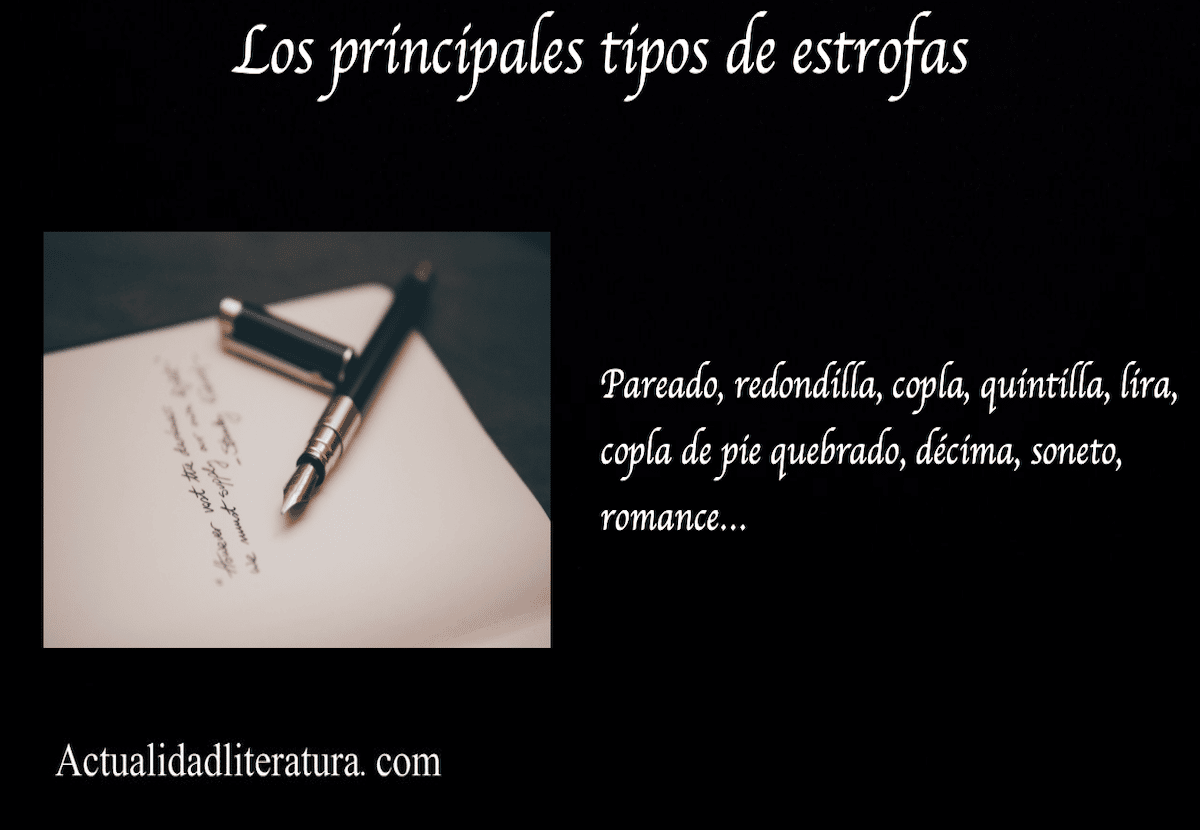
A stanza is a metric concept that classifies the types of verses and their way of being grouped. in a poetic composition. They are not distributed in the same way as a paragraph and it is important to analyze their arrangement because the rhyme will depend on it, the type of rhyme if it has one, the rhythm and length of the stanza and its verses.
As for the Royal Spanish Academy, it defines a stanza as "each one of the parts made up of the same number of verses and ordered in the same way as some poetic compositions". But without any doubt the best way to understand what a stanza is by seeing the different types that exist. We expose the main types of stanzas.
Semi-detached
Stanza that forms two verses with assonant or consonant rhyme. It is the simplest verse and can be quickly linked to popular sayings.
Example: "the one who is ashamed, / neither eats nor has lunch"
triplet
Three verses of major art (hendecasyllabic) with consonant rhyme and that sometimes appear as an autonomous stanza within a major poetic composition.
Example: «But I suffered you. I tore my veins / tiger and dove on your waist / in a duel of bites and lilies» (F. García Lorca).
Solea
Composition of three verses related to the popular poetry of Andalusia. They are minor art verses in assonance rhyme.
Example: «I have a want and a pity. / Grief wants me to live; / wanting wants me to die» (Manuel Machado).

Quartet
Composition with four hendecasyllabic verses or major art with consonant rhyme.
Example: "In what kingdom, in what century, under what silent / conjunction of the stars, on what secret day / that marble has not saved, did the courageous / and singular idea of inventing joy arise?" (Jorge Luis Borges).
redondilla
Grouping of four eight-syllable verses and consonant rhyme (first and fourth, third and second).
Example: "White dove of peace, / of war marks the end, / cover us with the morning light / cease the loquacious killing".
Serventesian
Four verses of eleven syllables with consonant rhyme; rhymes the first verse with the third and the second with the fourth verse.
Example: "I am the one who only said yesterday / the blue verse and the profane song, / in whose night there was a nightingale / that was a lark of light in the morning" (Rubén Darío).
quatrain
Similar to the redondilla, the quatrain is also four octosyllabic verses, but the second and fourth verses rhyme in assonance.
Example: «Light of the soul, divine light, / lighthouse, torch, star, sun… / A man gropingly walks; he carries a lantern on his back »(Antonio Machado).
Couplet
Poetic composition of four verses of minor art and assonance rhyme. Very common in popular songs.
Example: "I don't know what the wind says, / I don't know what the sea says, / but when I look at the horizon / I always start to cry."

Seguidilla
They are heptasyllabic and pentasyllabic verses and assonance rhyme.
Example: "Well, you walk in the palms, / holy angels, / my child falls asleep, / have the branches" (Lope de Vega).
Sash
Four Alexandrian verses (14 syllables) and consonant rhyme. It is a type of stanza used mainly in the Middle Ages (XNUMXth-XNUMXth centuries).
Example: «He was a simple clergyman, poor clergyman / said cutiano Missa de la Santa María; / I did not know how to say another, I said it every day, / I knew it more by use than by wisdom» (Gonzalo de Berceo).
limerick
Composition of five verses of minor art (octosyllables) and consonant rhyme. It can present metric variations.
Example: "I don't even imagine white wine / forty years old as fine / as your fragrant mouth: / that, like the lord the rose, / the wine smells of the villain" (Lope de Vega).
Quintet
Poetic structure similar to the limerick, but with verses of greater art; the rhyme is also consonant. Presents the variations of the limerick.
Example: "One night my father, I feel like a child, / watching the grief consume me, / with the phrases that only affection dictates, / launched the prophecy of my destiny, / one night my father, I feel like a child" (Julián of the House).
Lira
Grouping of five heptasyllabic and hendecasyllabic verses with consonant rhyme. Its origin is Italian and it can also be identified with the name of "half stay".
Example: «If my low lyre / could make the sound so much, that in a moment / it would appease the anger / of the spirited wind, / and the fury of the moving sea» (Garcilaso De la Vega).

Sextet
There are six verses of major art and consonant rhyme. There may be variations.
Example: «A row of seminarians parades, / bare cloths like the sopistas, / revelry tricornes, mountain blackness. / He Closes the train of gable mules / black and stilt-legged, without nuptial joys, / and the muleteer sings an Aragonese song »(Ramón del Valle-Inclán).
sextuplet
Six verses of minor art and consonant rhyme. Like the sextet, it can also present a metric scheme with variations.
Example: "Deep placidity, submissive / to the law, and in the gentle / brief mouth, a smile / enigmatic, subtle, / illuminating, indecisive, / the ivory-colored complexion" (Amado Nervo).
Broken foot couplet
Composition also called "copla manriqueña" by the author Jorge Manrique (XNUMXth century). It is composed of octosyllabic and tetrasyllabic verses, and its rhyme is consonant. Skip, therefore, the short or minor verse with the long or major.
Example of two couplets: «Remember the sleeping soul, / revive the brain and wake up / contemplating / how life passes, / how death comes / so silent, / how quickly pleasure leaves, / how, after agreeing , / gives pain; / how, in our opinion, / any past time / was better» (Jorge Manrique).
royal eighth
It is also known by the name of "eighth rhyme". It is a set of eight hendecasyllabic verses. The eighth real is divided into six verses with alternate rhyme and a couplet formed by the last two verses.
Example: «Bliss is dreaming when I wake up dreams / the heart of man his hope, / his mind flatters the smiling illusion, / and the present good reaches the future; / and after the aerial and luminous banner / of enthusiasm, the spirit is launched / under a sky of light and colors, / fields painting fragrant flowers» (José de Espronceda).
tenth or spinel
Composition of ten eight-syllable verses with consonant rhyme.
Example: «The rich man dreams of his wealth, / who offers him the most care; / dreams the poor who suffers / his misery and his poverty; / dreams the one who begins to thrive, / dreams the one who strives and pretends; / dreams the one who offends and offends; / and in the world, in conclusion, / everyone dreams of what they are / although no one understands it» (Calderón de la Barca).

Sonnet
Grouping of fourteen verses of major art (hendecasyllables), distributed as follows: two quatrains and two triplets. It arose in the Middle Ages and spread enormously through the Spanish language.
Example: «It is scorching ice, it is frozen fire, / it is a wound that hurts and cannot be felt, / it is a good dream, a present evil, / it is a very tired short rest. / It is an oversight that gives us care, / a coward, with a brave name, / a solitary walk among people, / a love only to be loved. / It is an imprisoned freedom, / that lasts until the last parasis, / disease that grows if it is cured. / This is the child Love, this is the abyss of him. / Look what friendship he will have with nothing / the one who is the opposite of himself in everything! » (Francisco de Quevedo).
Romance
Of Spanish origin, it consists of an undefined number of eight-syllable verses with assonance rhyme (the even ones) and loose verse (the odd ones). The themes are very varied, although it is a narrative poetic composition. Many romances have reached our days anonymously.
Fragment of a romance: «Among the loose horses / of the vanquished Zenetes, / who searched through the countryside / between the red and the green, / that Spaniard from Oran / a loose horse catches, / by its lush neighing / and by its fetlocks strong, / to take him, / and to take a captive Moor, / who is one who has captivated, / captain of a hundred Zenetes. / On the light horse / they both climb, and he seems, / with four spurs, wounded, / that four winds move him. / Sad the alarm walks, / and as low as it can / it throws ardent sighs / and sheds bitter tears [...] »(Luis de Góngora).
Silva
Metric form in which different heptasyllabic and hendecasyllabic verses follow one another (it may be longer or shorter). The verses can have different rhyme.
Fragment of a silva: «To the old elm, cleft by lightning / and in its half rotten, / with the rains of April and the sun of May / some new leaves have grown. / The hundred-year-old elm on the hill / that licks the Duero! A yellowish moss / stains the whitish bark / the rotten and dusty trunk. / It will not be, like the singing poplars / that guard the path and the shoreline. / inhabited by brown nightingales» (Antonio Machado).